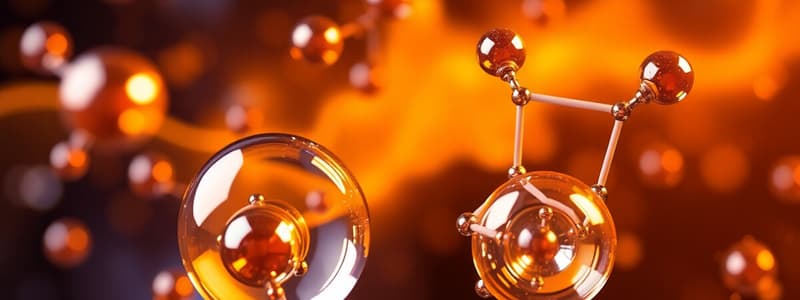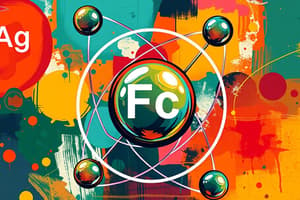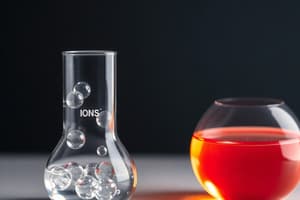Podcast
Questions and Answers
An ion of element X has a mass number of 37 and 18 electrons. How many neutrons are present in the nucleus of this ion?
An ion of element X has a mass number of 37 and 18 electrons. How many neutrons are present in the nucleus of this ion?
- 19 (correct)
- 17
- 18
- 20
Which of the following statements correctly describes the relationship between the number of protons, neutrons, and electrons in a neutral atom?
Which of the following statements correctly describes the relationship between the number of protons, neutrons, and electrons in a neutral atom?
- The number of neutrons always equals the number of protons plus electrons.
- The number of electrons always equals the number of neutrons.
- The number of protons always equals the number of neutrons.
- The number of protons always equals the number of electrons. (correct)
An atom of element Y has a mass number of 80 and contains 45 neutrons. How many protons and electrons does a neutral atom of element Y have, respectively?
An atom of element Y has a mass number of 80 and contains 45 neutrons. How many protons and electrons does a neutral atom of element Y have, respectively?
- 45 protons and 45 electrons
- 45 protons and 35 electrons
- 35 protons and 45 electrons
- 35 protons and 35 electrons (correct)
Element Z is located in Group 16 (also known as the chalcogens) of the periodic table. What can you infer about the number of electrons in the highest energy level (outer shell) of a neutral atom of element Z?
Element Z is located in Group 16 (also known as the chalcogens) of the periodic table. What can you infer about the number of electrons in the highest energy level (outer shell) of a neutral atom of element Z?
An isotope of carbon has a mass number of 14. How many neutrons does this isotope have?
An isotope of carbon has a mass number of 14. How many neutrons does this isotope have?
An atom has an electronic configuration of 2, 8, 5. To which period and group of the periodic table does it belong?
An atom has an electronic configuration of 2, 8, 5. To which period and group of the periodic table does it belong?
If an element has 19 protons, what is its electronic configuration and to which group does it belong?
If an element has 19 protons, what is its electronic configuration and to which group does it belong?
Which of the following describes the characteristics of elements located in the same period on the periodic table?
Which of the following describes the characteristics of elements located in the same period on the periodic table?
Flashcards
Atom
Atom
Basic building block of matter, containing protons, neutrons, and electrons.
Atomic Number (Z)
Atomic Number (Z)
The number of protons in an atom's nucleus; it determines the element.
Mass Number (A)
Mass Number (A)
The total number of protons and neutrons in an atom's nucleus.
Ion
Ion
Signup and view all the flashcards
Cation
Cation
Signup and view all the flashcards
Anion
Anion
Signup and view all the flashcards
Electronic Configuration
Electronic Configuration
Signup and view all the flashcards
Periods (Periodic Table)
Periods (Periodic Table)
Signup and view all the flashcards
Study Notes
- An atom is the basic building block of matter.
- An atom is composed of a nucleus and electronic shells.
- The nucleus contains protons, which have a positive charge, and neutrons, which have a neutral charge.
- Electronic shells contain electrons, which have a negative charge.
- There are more than 100 different types of atoms.
- The number of protons determines the type of atom.
- The atomic number (Z) is the number of protons in an atom.
- The mass number (A) is the number of protons plus the number of neutrons in an atom.
- The symbol of an atom is represented as A/Z X, where A is the mass number, Z is the atomic number, and X is the element symbol.
Example: Calcium
- Calcium (Ca) has a mass number of 40 and an atomic number of 20.
- Calcium has 20 protons, 20 neutrons (40-20 = 20), and 20 electrons.
Example: Chlorine
-
Chlorine (Cl) has a mass number of 35 and an atomic number of 17.
-
Chlorine has 17 protons, 18 neutrons (35-17 = 18), and 17 electrons.
-
An ion is a charged atom.
-
A cation is a positive ion that has lost electrons.
-
An anion is a negative ion that has gained electrons.
-
Ions form by losing or gaining electrons.
Examples
- Aluminum (Al) has 13 protons and typically 14 neutrons in its neutral form. As an ion with a +3 charge, it has 10 electrons (13 - 3 = 10).
- Chlorine (Cl) has 17 protons and typically 18 neutrons in its neutral form. As an ion with a -1 charge, it has 18 electrons (17 + 1 = 18)
Given Examples
- Atom 1 has 9 protons, 10 neutrons, and 9 electrons (Fluorine).
- Atom 2 has 10 protons, 9 neutrons, and 10 electrons (Neon).
- An element has 17 neutrons in the nucleus and a mass number of 35, it has 18 protons (35-17 = 18), and is the element Argon.
Studying That Suits You
Use AI to generate personalized quizzes and flashcards to suit your learning preferences.
Related Documents
Description
Explore the fundamental components of atoms, including protons, neutrons, and electrons. Learn how the number of protons defines the type of atom and how to calculate the number of neutrons. Examples of Calcium and Chlorine are included.




